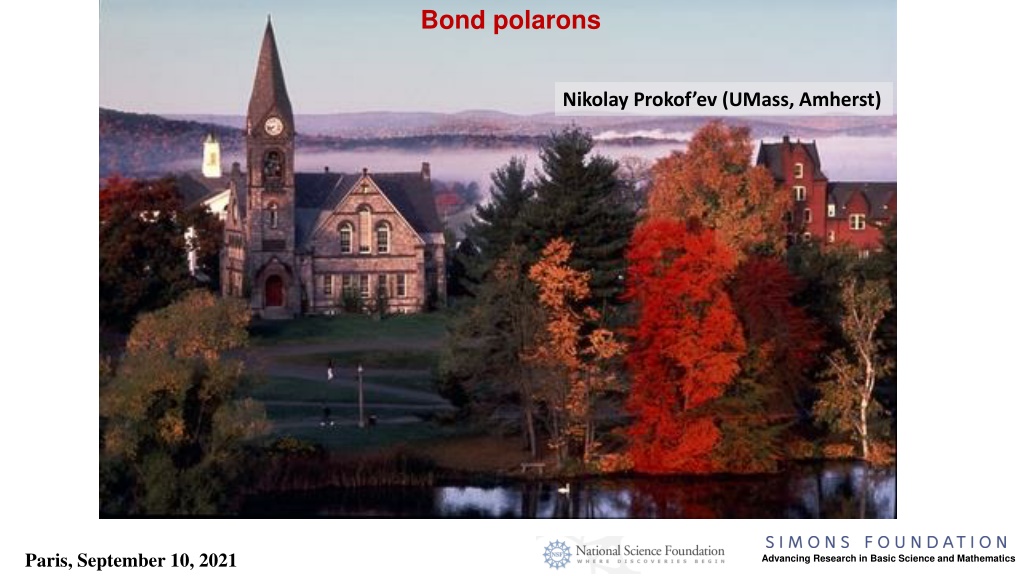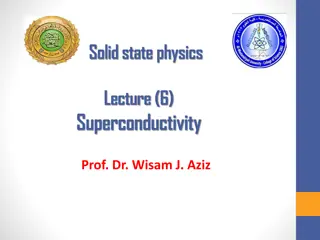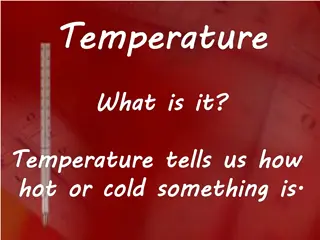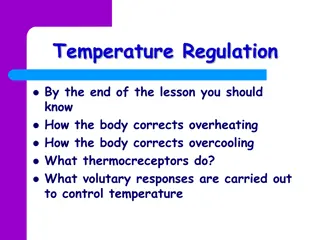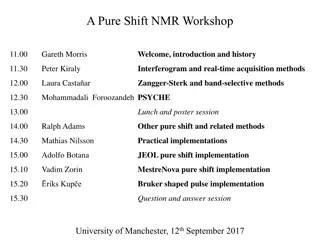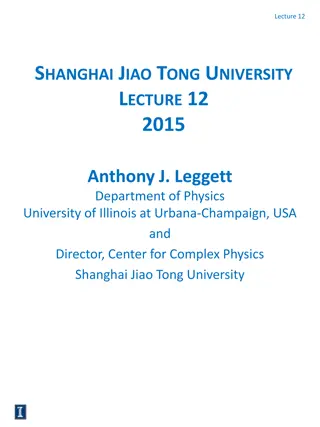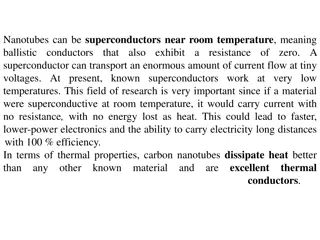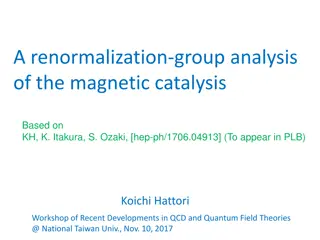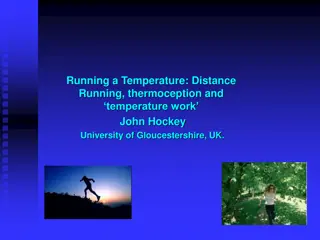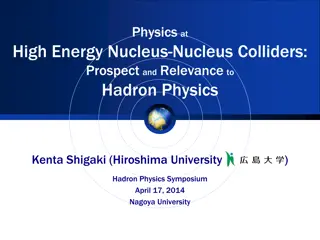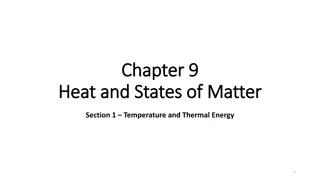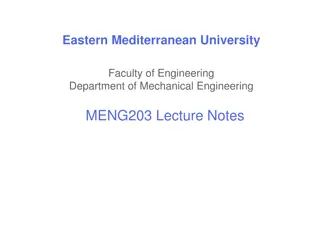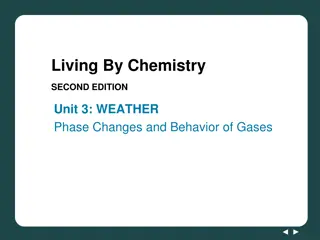Exploring the Role of Bi-Polarons in High Temperature Superconductivity Research
This research delves into the concept of bi-polarons and their potential involvement in high-temperature superconductivity mechanisms. Collaborators from various institutions are investigating the properties and interactions of bi-polarons, considering factors like effective mass and density. The study compares standard polarons with density-displacement coupling and introduces models for bond polarons or PSSH polarons with displacement-modulated hopping. The discussion also touches on the challenges posed by the weight of Holstein bi-polarons and their implications in tight-binding Hamiltonians. Overall, the research aims to advance knowledge in basic science and mathematics related to polarons and their impact on superconductivity.
Download Presentation

Please find below an Image/Link to download the presentation.
The content on the website is provided AS IS for your information and personal use only. It may not be sold, licensed, or shared on other websites without obtaining consent from the author. Download presentation by click this link. If you encounter any issues during the download, it is possible that the publisher has removed the file from their server.
E N D
Presentation Transcript
Bond polarons Nikolay Prokof ev (UMass, Amherst) Simons Foundation Paris, September 10, 2021 Advancing Research in Basic Science and Mathematics
Collaborators: Chao Zhang (UMass and Boris Svistunov (UMass Amherst) East China Normal University, Shanghai) arXiv:2108.06725 PRB 21 M. Berciu, D. Marchand, P.C.E. Stamp (UBC, Vancouver) G. De Filippis, V. Cataudella (Universit di Napoli) N. Nagaosa, A.S. Mishchenko (Uniuversity of Tokyo, RIKEN-Saitama) PRL 2010 J. Sous, A, Millis, D. Reichman (Columbia) In progress
Polaron: One impurity in the environment Bi-Polaron: Two impurities in the same environment forming a bound state What is next? Main question: Can bi-polarons provide the high-TC mechanism? 1 ~ T C 2 m R * Bi-polaron radius Bi-polaron effective mass
Recall BCS-BEC crossover 1 ~ T Why ? C 2 m R * Bi-polaron effective mass Bi-polaron radius Similar, but in absolute terms T C 2/d n : T C m Push the bi-polaron density to the limit d nR : 1 1 BEC BCS 1/ F k R
2/d n : T estimate is very robust against repulsive interactions between bi-polarons! C m 1.84 n m 2/ d n T = 2D: 3.31 T 3D: C 1 0.3lnln(1/ + 2 ) na C m Barely any dependence on interactions. (even in He-4 the ideal gas formulais only 30% wrong) Double-logarithmically weak dependence! NP, O. Ruebenacker, B. Svistunov, PRL 01 Hard spheres Soft spheres Hard disks P. Gruter, D. Ceperley, F. Laloe, PRL 97 ; K. Nho and D.P. Landau, PRA 04 ; S. Pilati, S Giorgini, NP, PRL 08
= + + int H H H H Standard polarons with density-displacement coupling: particle phonons = H g n X int ij i j ij = i n a a electron density i i = + j X b b oscillator displacement j j e e Holstein model (on-site coupling): = H g n X int i i i
Bond polarons or PSSH (Peierls-Su-Schrieffer-Heeger) polarons with displacement modulated hopping: = + j i ( ) H g a a a a X ij ij = + j i ( )( ) H g a a a a X X int i j ij int i j i j ij ij e e Model B Model A
Can bi-polarons be responsible for the high-TC mechanism? No, because Holstein bi-polarons are exponentially heavy when they form [Chakraverty, Ranninger, Feinberg, PRL 98] = + j i = H t a a a a 4 ? W dt Take tight-binding Hamiltonain with bandwidth (cubic lattice) phonon frequency p E particle i j ph ij E p k k W 2 g 4 dt 2 p ph 2 2 2 2 W g W W g g W g Band perturbation theory: Localized electron: exp # E * E p p 2 ph 2 2 2 ph ph overlap integral between phonon clouds W W W W ph = exp g Light-to-heavy crossover at with 1 2 2 * ph
Sharp crossover from light to heavy polarons E 2 W light polaron branch 2 Heavy polaron branch 1
Can bi-polarons be responsible for the high-TC mechanism? No, because the are exponentially heavy when they form. W 22 E W Two band polarons: p W g ph = g 1 2 Crossover to bi-polaron at 2 2 2 g 4 E Localized bi-polaron: p ph 2 p ( ) t g W 2 2 2 ph g t d t d W 2 = = 2 exp 2 exp t with as heavy effective mass bi /2 2 ph For in d=2 we get ph /2 t = /2 2 / W dt = 3 10 4 e e ph ph Realistically even is hard to get ph /4 t =
Berciu, Marchand, Stamp, Filippis, Cataudella, Nagaosa, Mishchenko, NP, PRL 10 Sous, Chakraborty, Krems, Berciu, PRL 18 One-dimensional Model A e ij ij = + )( j i ( ) H g a a a a X X int i j i j ij leads to sign-alternating diagrammatic expansion both in real and momentum space M M ' ' kk pp // // // ' p p ' k k g i g = 2 [sin( ') sin( ) ig p ] M p // ' pp 1 2 In momentum space sign-problem is not as severe. But in 1D one can also afford other methods, e.g. controlled truncation of Hilbert space for diagonalization.
One-dimensional Model A e = 2 cos( ) t Ground state shifts to non-zero momentum 'cos(2 ) K p t p eff 2 / 0 t g 2 ph = ph/ 0.5 t Effective mass is NOT exponentially suppressed at strong coupling in 1D = ph/ 3 t
Zang, Svistunov, NP arXiv:2104.14044 2D Model A 2D Model B k q 1/2 = + k ( , ) k q H.c. H V M c c b k k k int ' , ' e , , = ) sin( e ' ( , ') k k 2 [sin( ig )] (mod el A ) M k k = + ' ( , ') k k 2 cos[( g )/ 2] (model ) B M k k Standard Diagrammatic Monte Carlo for Green s function diagrams. Always convergent for finite but sign-problem kicks in for large expansion orders. Look similarly in momentum representation but have rather different properties
2D Model A Ground state shifts to non-zero momentum along the diagonal in BZ = ph/ 3 t = ph/ 0.5 t Effective mass is NOT exponentially suppressed as yet for this coupling range Effective mass is slightly anisotropic after the transition
2D Model B Ground state is always at k=0 Effective mass is NOT exponentially suppressed here (at least not yet ) 1 ~ T What about bi-polarons and prospects for high BEC temperature? C 2 m R *
= + ( + ) j i ij D Model B ( ) H g a a a a b b int i j ij ij Has sign-positive diagrammatic expansion in real space e j // // g g i 1 2 is easy to generalize to dispersive phonons and account for inter-particle interactions (for bi-polarons) // g g U U // g g
D Model B Math. to simulate: 1r g N 2 /2 U Kinks g t ph ( ) Kinks ( , ) exp ( ) s ds td D r r U 0 ph ' ' pot j j j j 2 Kinks N phonons 0 ph phonon propagator j g Potential energy of interparticle interactions 2r ( , , ) r r G 2 1 2 ' 1. Change imaginary time: 1 Kinks Kinks 2. Increase/decrease the number of kinks: MC updates: 1 N N 3. Add/remove phonon lines between kinks: ph ph 4. Add more (if necessary for better decorrelation )
Results for bi-polarons in 2D Model B e Very robust against Hubbard U But are far more heavy than single polarons!
Radial profile of the bound state = = ; 0.5 g t t ph = = ; 0.5 g t t ph The bi-polaron radius goes up with U but remains relatively small Large repulsive U helps s-wave superconductivity!
Relatively shallow states to begin with have much lighter effective masses and the radius effect dominates: TC is suppressed with U
In between two extremes: TC maximum at U=8t from compromise between the bi-polaron mass and size
Main question: Can bi-polarons be responsible for the high-TC mechanism? 1 ~ T C 2 m R * = = Take: / 0.5 and / 8: t U t ph g t = / 0.707 g t = / 1 / ~ 5 m m * 2 0 / ~ 65 m R m g t = / 0.8 * 2 0 ~ T 3 R 1 / ~ 10 m m ~ 0.2 5 * 2 0 C ph ~ 0. 12 T ~ 1. 2 R C ph ~ 0.3 3 T C ph Yes, this is very high Tc estimate!
McMillans [Phys Rev 167, 331 (1968) ] expression utilizing Eliashberg theory [Sov. Phys. JETP 11 696 (1960) ] + e ph 1.04(1 ) 1 = exp T T C D e ph (1 0.62 + * 1.45 ) e ph * 0.12 with 1 There is no Eliashberg theory for because a localized bi-polaron state has much better energy
Just a curious fact: for (particles are slower than phonons) 3 t = ph/ bi-polarons are lighter than twice the polaron mass
Conclusions and questions: Bond polarons and bi-polarons appear to be much lighter than Holstein polarons Bond bi-polarons are robust against local repulsive interactions High TC is not automatic because compact bi-polarons are heavy and light bi- polarons have large size. Best estimates of bi-polaron Tc are significantly higher than the best predictions based on Eliashberg (Fermi-liquid) formula bi m Will phonon dispersion help to reduce ? t bi Is the large problem more severe for ? (likely yes) m ph How all results change in 3D when finite coupling is required for bound states to exist?
